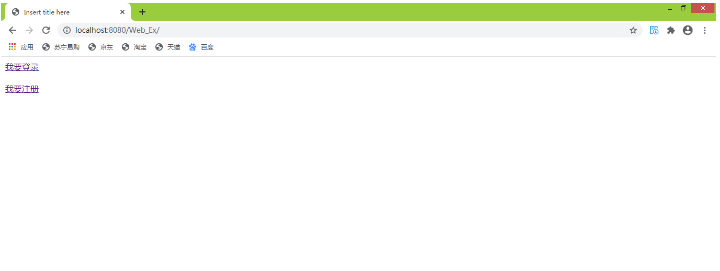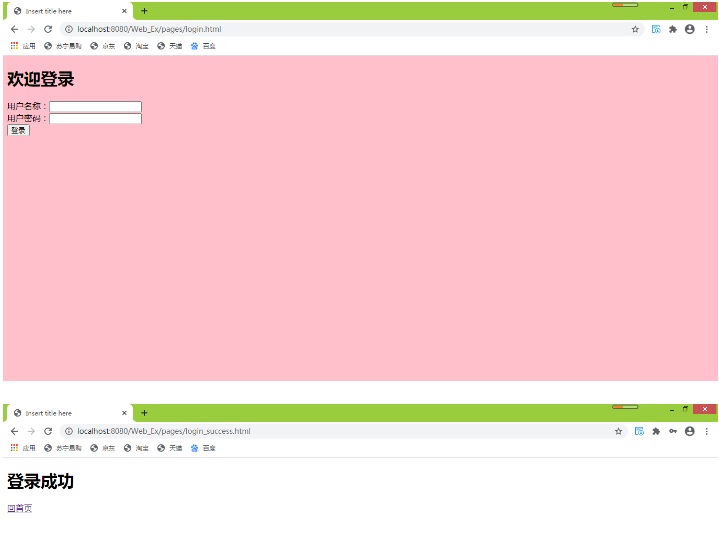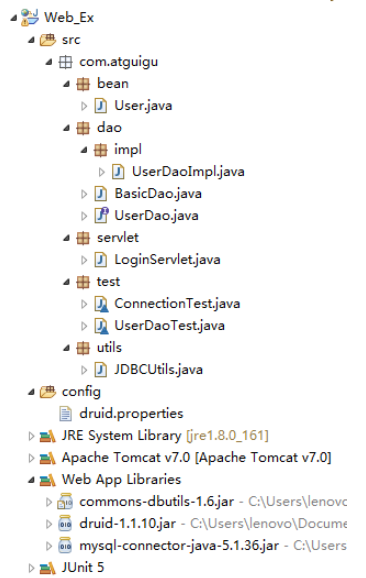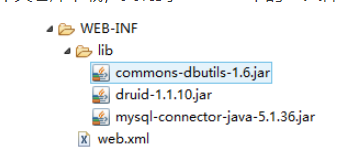这篇文章主要介绍“怎么用JavaWeb实现登录功能”的相关知识,小编通过实际案例向大家展示操作过程,操作方法简单快捷,实用性强,希望这篇“怎么用JavaWeb实现登录功能”文章能帮助大家解决问题。
本项目实现了登录功能。点击首页的“我要登录”链接跳转到登录页面。在登录页面,输入用户名和密码,点击登录,提交给LoginServlet处理。查询数据库表中的数据。如果用户名和密码正确,会跳转到登录成功页面;如果用户名或密码错误,请求将被转发到登录页面。


开发工具:spring-tool-suite-4
数据库:Mysql
服务器:tomcat7
jdk:1.8
/*
Navicat MySQL Data Transfer
Source Server : localhost
Source Server Version : 50716
Source Host : localhost:3306
Source Database : test
Target Server Type : MYSQL
Target Server Version : 50716
File Encoding : 65001
Date: 2020-07-30 10:28:07
*/SET FOREIGN_KEY_CHECKS=0;-- ------------------------------ Table structure for users-- ----------------------------DROP TABLE IF EXISTS `users`;CREATE TABLE `users` ( `id` int(11) NOT NULL AUTO_INCREMENT, `username` varchar(100) NOT NULL, `password` varchar(100) NOT NULL, `email` varchar(100) DEFAULT NULL,
PRIMARY KEY (`id`)
) ENGINE=InnoDB AUTO_INCREMENT=2 DEFAULT CHARSET=utf8;-- ------------------------------ Records of users-- ----------------------------INSERT INTO `users` VALUES ('1', 'admin', '123456', 'admin@atguigu.com');4.项目实施

(1)在bean包中,我们实现了User实体类,定义了User对象的私有成员变量,封装了get和set方法,构造了带参数和不带参数的方法,重写了toString方法
package com.atguigu.bean;public class User {
private int id; private String username; private String password; private String email;
public User() { super();
} public User(int id, String username, String password, String email) { super(); this.id = id; this.username = username; this.password = password; this.email = email;
} public int getId() { return id;
} public void setId(int id) { this.id = id;
} public String getUsername() { return username;
} public void setUsername(String username) { this.username = username;
} public String getPassword() { return password;
} public void setPassword(String password) { this.password = password;
} public String getEmail() { return email;
} public void setEmail(String email) { this.email = email;
} @Override
public String toString() { return "User [id=" + id + ", username=" + username + ", password=" + password + ", email=" + email + "]";
}
}(2)在dao包中定义了User dao接口,使用User daoimpl类继承该接口,重写了接口中的checkUsernameAndPassword方法。该方法可以根据用户名和密码查询数据库中的相应记录。如果是,则返回一个 User 对象;否则返回 null
用户道接口代码如下
package com.atguigu.dao;import com.atguigu.bean.User;public interface UserDao { /**
* Query the corresponding records in the database according to the user name and password
* @param username
* @param Password
* @return User This record is null, but there is no such record
*/
User checkUsernameAndPassword(String username,String Password);
}UserDaoImpl 代码如下
package com.atguigu.dao.impl;import com.atguigu.bean.User;import com.atguigu.dao.BasicDao;import com.atguigu.dao.UserDao;public class UserDaoImpl implements UserDao { //establish BasicDao object
BasicDao basicDao = new BasicDao();
@Override
public User checkUsernameAndPassword(String username, String password) { //write sql sentence
String sql = "select id,username,password,email from users where username = ? and password = ?";
User user = basicDao.getBean(User.class, sql, username,password); return user;
}
}BasicDao 类提供了用于添加、删除、修改和查询数据库的 Dao。代码如下
package com.atguigu.dao;import java.sql.Connection;import java.sql.SQLException;import org.apache.commons.dbutils.QueryRunner;import org.apache.commons.dbutils.handlers.BeanHandler;import com.atguigu.utils.JDBCUtils;public class BasicDao { /*
* Dao is provided to add, delete and modify the database
*/
private QueryRunner queryRunner = new QueryRunner();
/**
* General method of adding, deleting and modifying
* @param sql
* @param params
* @return
*/
public int update(String sql,Object... params) { //Get connection
Connection connection = JDBCUtils.getConnection(); int count = 0; try {
count = queryRunner.update(connection, sql, params);
}catch(SQLException e) {
e.printStackTrace();
}finally {
JDBCUtils.releaseConnection(connection);
} return count;
}
/**
* Method to get an object
* @param <T>
* @param type
* @param sql
* @param params
* @return
*/
public <T> T getBean(Class<T> type,String sql,Object... params) { //Get connection
Connection connection = JDBCUtils.getConnection();
T t = null; try {
t = queryRunner.query(connection, sql, new BeanHandler<T>(type), params);
}catch(SQLException e) {
e.printStackTrace();
}finally {
JDBCUtils.releaseConnection(connection);
} return t;
}
}(3)在servlet包下定义了一个servlet,LoginServlet。doGet 和 doPost 方法用于处理用户登录请求
package com.atguigu.servlet;import java.io.IOException;import javax.servlet.RequestDispatcher;import javax.servlet.ServletException;import javax.servlet.http.HttpServlet;import javax.servlet.http.HttpServletRequest;import javax.servlet.http.HttpServletResponse;import com.atguigu.bean.User;import com.atguigu.dao.UserDao;import com.atguigu.dao.impl.UserDaoImpl;/**
* Servlet s that handle user login
*/public class LoginServlet extends HttpServlet { private static final long serialVersionUID = 1L;
public LoginServlet() { super();
} protected void doGet(HttpServletRequest request, HttpServletResponse response) throws ServletException, IOException { //Get user name and password
String username = request.getParameter("username");
String password = request.getParameter("password"); //establish UserDao object
UserDao userDao = new UserDaoImpl(); //call UserDao The password and user name verification method
User user = userDao.checkUsernameAndPassword(username, password); if(user != null) { //The user name and password are correct
response.sendRedirect(request.getContextPath()+"/pages/login_success.html");
}else { //Username or password incorrect
//Get transponder
RequestDispatcher requestDispatcher = request.getRequestDispatcher("/pages/login.html"); //Forward request
requestDispatcher.forward(request, response);
}
} protected void doPost(HttpServletRequest request, HttpServletResponse response) throws ServletException, IOException {
doGet(request, response);
}
}(4) 测试包,负责单元测试
ConnectionTest 类测试数据库是否连接成功
package com.atguigu.test;import java.sql.Connection;import org.junit.jupiter.api.Test;import com.atguigu.utils.JDBCUtils;class ConnectionTest { @Test
void test() {
Connection connection = JDBCUtils.getConnection();
System.out.println(connection);
}
}UserdaoTest类测试UserDao接口的方法是否可以实现
package com.atguigu.test;import org.junit.jupiter.api.Test;import com.atguigu.bean.User;import com.atguigu.dao.UserDao;import com.atguigu.dao.impl.UserDaoImpl;class UserDaoTest {
UserDao userDao = new UserDaoImpl();
@Test
void testCheckUsernameAndPassword() {
User user = userDao.checkUsernameAndPassword("admin", "123456");
System.out.println(user);
}
}(5)utils包下定义了JDBC utils工具类,用于获取和释放Connection连接
package com.atguigu.utils;import java.sql.Connection;import java.sql.SQLException;import java.util.Properties;import javax.sql.DataSource;import com.alibaba.druid.pool.DruidDataSourceFactory;/*
* Tool class for getting and releasing connections
*/public class JDBCUtils { private static DataSource dataSource;
static { try { //1,read druid.properties file
Properties pro = new Properties();
pro.load(JDBCUtils.class.getClassLoader().getResourceAsStream("druid.properties"));
//2,Connection pool
dataSource = DruidDataSourceFactory.createDataSource(pro);
}catch(Exception e) {
e.printStackTrace();
}
}
//Get connection
public static Connection getConnection() {
Connection connection = null; try {
connection = dataSource.getConnection();
}catch(SQLException e) {
e.printStackTrace();
} return connection;
}
//Release the connection
public static void releaseConnection(Connection connection) { if(connection != null) { try {
connection.close();
} catch (SQLException e) {
e.printStackTrace();
}
}
}
}(6)在config源文件中,定义druid配置文件,配置数据库连接池的相关属性
# key=valuedriverClassName=com.mysql.jdbc.Driver url=jdbc:mysql://localhost:3306/test?rewriteBatchedStatements=true username=root password=root initialSize=10 minIdle=5 maxActive=20 maxWait=5000
(7)jar包说明:对应的jar包可以从maven中央仓库下载,复制到WEB-INF下的lib文件夹下

(8)首页说明

索引,html页面代码
<!DOCTYPE html><html><head><meta charset="UTF-8"><title>Insert title here</title><!-- base In the label href Property makes the relative path in the current page an absolute path --><base href="http://localhost:8080/Web_Ex/"></head><body> <!-- with / The first path is the absolute path In absolute path / What does it stand for If the path is resolved by the browser, then / On behalf of http://localhost:8080/ Which paths are resolved by the browser? 1)HTML The path in the label, such as a In the label href The path in the property, form In the label action Path in attribute, etc 2)Paths in redirection If the path is resolved by the server, then / On behalf of http://localhost:8080/Web_Ex/ Which paths are resolved by the server? 1)web.xml In the configuration file url-pattern Path in label 2)Path in forwarding --> <a href="pages/login.html">I want to log in</a><br><br> <a href="#">I want to register</a></body></html>
login.html 页面代码
<!DOCTYPE html><html><head><meta charset="UTF-8"><title>Insert title here</title><style type="text/css">
body{ background-color: pink;
}</style><!-- base In the label href Property makes the relative path in the current page an absolute path --><base href="http://localhost:8080/Web_Ex/"></head><body>
<h1>Welcome to login</h1>
<form action="LoginServlet" method="post">
User name:<input type="text" name="username" /><br>
User password:<input type="password" name="password" /><br>
<input type="submit" value="Sign in">
</form></body></html>login_success.html 代码
<!DOCTYPE html><html><head><meta charset="UTF-8"><title>Insert title here</title><!-- base In the label href Property makes the relative path in the current page an absolute path --><base href="http://localhost:8080/Web_Ex/"></head><body> <h1>Login successful</h1> <a href="index.html">Home </a></body></html>
关于“怎么用JavaWeb实现登录功能”的内容就介绍到这里了,感谢大家的阅读。如果想了解更多行业相关的知识,可以关注亿速云行业资讯频道,小编每天都会为大家更新不同的知识点。
免责声明:本站发布的内容(图片、视频和文字)以原创、转载和分享为主,文章观点不代表本网站立场,如果涉及侵权请联系站长邮箱:is@yisu.com进行举报,并提供相关证据,一经查实,将立刻删除涉嫌侵权内容。